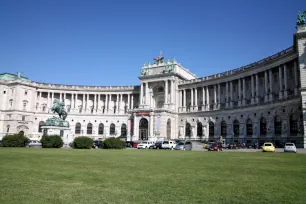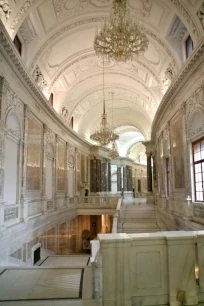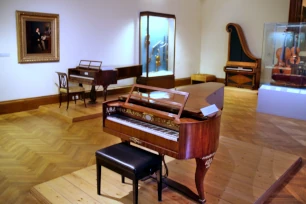The Neue Burg was built in 1881-1913 as a new wing of the imperial palace and as such symbolizes the last convulsions of the Habsburg Empire. Today it is home to a number of interesting museums.
Hofburg expansion
The Kaiserforum

In the mid-nineteenth century, Emperor Franz-Joseph II decided to expand the Hofburg, the imperial palace of the Habsburg rulers. In 1866 a competition was organized to determine the design. Several of Austria’s foremost architects including Heinrich von Ferstel, Moritz Löhr, Theophil von Hansen and Carl von Hasenauer all submitted designs, but none of the proposals were deemed satisfactory by the emperor.
He appointed Gottfried Semper, an accomplished German architect, who came up with a general plan based on a proposal by Carl von Hasenauer. The ambitious plan, which was called Kaiserforum, included the construction of two identical museum buildings (Kunsthistorisches and Naturhistorisches Museum) and two new palace wings (Neue Hofburg), all connected by triumphal arches across the Ringstraße. This resulted in the creation of two new squares: Maria-Theresien-Platz and Heldenplatz.

The Neue Burg
Construction of the Neue Hofburg, which consisted of two mirroring semicircular wings arranged around Heldenplatz, started in 1881. Due to political and financial difficulties, work continued at a snail’s pace. The first wing was finally completed in 1913, but the outbreak of the First World War and subsequent collapse of the empire halted further construction. As a result, the planned north-west wing and the triumphal arches were never built.
The building we see today is a bombastic structure in Neo-Baroque style. Its curving facade, which seems to embrace Heldenplatz, consists of a monumental arch with a colonnade on either side. The equestrian statue in front of the Neue Burg shows the Austrian hero Eugène of Savoy, who crushed the Turkish invaders in the seventeenth century.
Museums
The completed south-east wing, now known as “Neue Burg”, was never actually used as a palace. Today it houses the main reading room of the national library, and it is home to no less than four museums.

Hofjagd- und Rüstkammer
The Hofjagd- und Rüstkammer (Imperial Hunting Museum and Armory) boasts one of the largest collections of arms and armor in the world. The collection includes weaponry from all across Europe, including Spain, Italy, France, the Netherlands and Flanders. Some of the most beautiful items date from the Renaissance era, when German and Italian artists created fabulous custom-made armor for the Habsburg royals. There’s also a selection of Ottoman weapons that were taken as spoils during the wars with the Turks in the seventeenth century.
Ephesos-Museum
At the end of the nineteenth century, Austrian archaeologists brought antiquities they had discovered in Turkey and Greece to Vienna. Most of the items were excavated in the ancient city of Ephesus in Asia Minor. Ephesus was one of the most important cities of the ancient world. In Roman times it had more than 200,000 inhabitants.
The star attraction is the forty meter-long Parthian Monument from the second century AD, which is magnificently sculpted with figures in high relief. Another highlight is the sculpture of an Amazon from the Temple of Artemis and a bronze statue of an athlete. The museum also displays some finds from the Greek island Samothrace.
Sammlung alter Musikinstrumente

The Sammlung alter Musikinstrumente (Collection of Historic Musical Instruments) in the Neue Burg boasts one of the world’s most important collections of musical instruments from the Renaissance and Baroque periods. Quite fitting for a city that is so closely associated with famous composers such as Mozart, Haydn and Strauss.
You can see instruments that were once played by those composers, but even more interesting are the instruments that are virtually unplayable, since they were merely created for their beauty. One of these is a violin built from a tortoise shell that is decorated with gold and ivory. The museum is particularly renowned for its collection of clavichords and harpsichords from the Renaissance period.
Weltmuseum
The Weltmuseum (World Museum), formerly known as the Museum für Völkerkunde, is a museum of Ethnology. One of the highlights of this museum is a stunning, gilded feather headdress from the fifteenth century that was worn by the Aztec king Moctezuma. There are also some fine bronze sculptures from the African kingdom of Benin.
- Next: Prater
- More Sights & Attractions in Vienna

